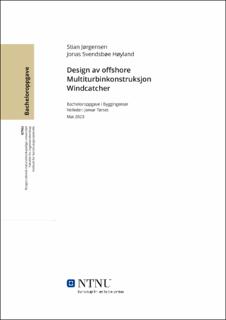| dc.contributor.advisor | Tørset, Jomar | |
| dc.contributor.author | Jørgensen, Stian | |
| dc.contributor.author | Svendsbøe Høyland, Jonas | |
| dc.date.accessioned | 2023-07-08T17:23:36Z | |
| dc.date.available | 2023-07-08T17:23:36Z | |
| dc.date.issued | 2023 | |
| dc.identifier | no.ntnu:inspera:146719958:46734704 | |
| dc.identifier.uri | https://hdl.handle.net/11250/3077388 | |
| dc.description.abstract | Denne bacheloroppgaven tar for seg et forenklet design av en offshore multiturbinkonstruksjon, som har utforming inspirert av konstruksjonen til Windcatching Systems AS. Konstruksjonen som designes skal være 300 meter høy og 300 meter bred, og skal bære 100 mindre vindturbiner.
Hovedmaterialet i konstruksjonen er stål. Stål fremstår som ett av verdens viktigste byggematerialer. Sett i et livsløpsperspektiv er stål miljøvennlig og bestandig. Materialet fremstår som 100% resirkulerbart og vil spille en viktig rolle i det grønne skiftet. Stål er mye benyttet ettersom det har en høy styrke, lang levetid og er enkel å vedlikeholde.
Stavelementer og sveiser designes for å motstå statiske vindlaster, samt egenvekt av stavene og vindturbinene. De dimensjonerende statiske vindlastene blir regnet ut i henhold til gyldige standarder og regelverk. Egenvekten av stavelementer blir beregnet i henhold til massetettheten av valgt stålmateriale, mens egenvekten av vindturbiner kommer fra egen antakelse.
Konstruksjonen er designet etter to forskjellige beregningsmodeller; fagverksmodell og rammemodell. Det ble studert hvordan valg av beregningsmodell påvirket statikken i konstruksjonen, kraftforløp, detaljutforming av knutepunkter og nødvendige tverrsnitts dimensjoner. Fagverksmodellen ble dimensjonert etter aksial og knekkapasitet, mens rammemodellen ble kontrollert mot aksial, skjær, bøyemoment, bøyeknekk og knutepunkts kapasitet. Design-resultatene er utført etter bruddgrensetilstand (ULS) for to ulike lasttilfeller; full dimensjonerende vindlast og uten vindlast. Det konkluderes med at rammemodellen gir best forutsetning for et design av denne konstruksjonen.
I diskusjonen drøfter gruppa rundt valg som er tatt og hvilke endringer vi kunne gjort. Det diskuteres også dynamiske laster som er utelatt fra analysen og hvordan disse ville påvirket konstruksjonen. Resultatene våre for tverrsnitts dimensjoner endte litt for store i forhold til hva som egner seg for en flytende offshore konstruksjon. Dette drøftes også under diskusjon. | |
| dc.description.abstract | This bachelor's thesis addresses a simplified design of an offshore multi-turbine structure, which has a design inspired by the construction of Windcatching Systems AS. The structure being designed is going to be 300 meters high and 300 meters wide and should bear 100 smaller wind turbines.
The main material in the construction is steel. Steel stands out as one of the world's most important building materials. From a lifespan perspective, steel is environmentally friendly and resistant. The material is 100% recyclable and will play an important role in the green transition. Steel is widely used because it has high strength, long lifespan, and is easy to maintain.
Structural elements and welds are designed to resist static wind loads, as well as the self-weight of the columns and wind turbines. The static wind loads are calculated in accordance with valid standards and regulations. The self-weight of the structural elements is calculated based on the mass density of the chosen steel material, while the self-weight of the wind turbines comes from own assumptions.
The construction is designed according to two different calculation models: truss model and frame model. It was studied how the choice of calculation model affected the statics of the structure, force flow, detail design of nodal points, and necessary cross-sectional dimensions. The truss model was dimensioned according to axial and buckling capacity, while the frame model was checked against axial, shear, bending moment, buckling, and nodal point capacity. The design results are performed according to ultimate limit state for two different load cases: full dimensioning wind load and without wind load. It is concluded that the frame model provides the best prerequisite for a design of this structure.
In the discussion, the group reflects on the choices that were made and what changes we could have made. Dynamic loads that are omitted from the analysis and how these would have affected the structure are also discussed. Our results for cross-sectional dimensions ended up a bit too large compared to what is suitable for a floating offshore construction. This is also discussed in the discussion section. | |
| dc.language | nob | |
| dc.publisher | NTNU | |
| dc.title | Design av offshore Multiturbinkonstruksjon Windcatcher | |
| dc.type | Bachelor thesis | |
